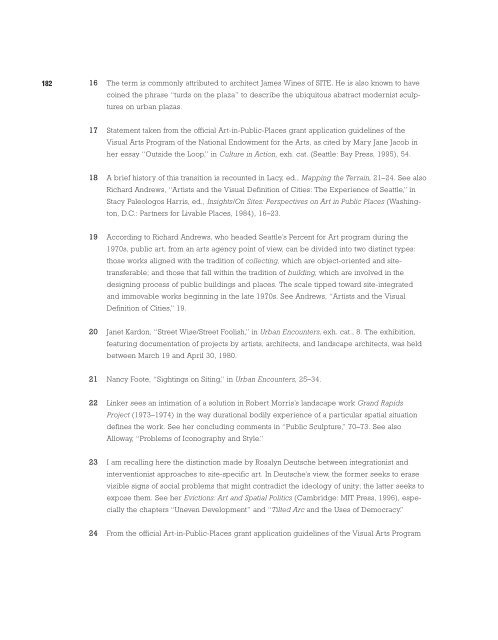ONE PLACE AFTER ANOTHER - Monoskop
ONE PLACE AFTER ANOTHER - Monoskop
ONE PLACE AFTER ANOTHER - Monoskop
Create successful ePaper yourself
Turn your PDF publications into a flip-book with our unique Google optimized e-Paper software.
182<br />
16 The term is commonly attributed to architect James Wines of SITE. He is also known to have<br />
coined the phrase “turds on the plaza” to describe the ubiquitous abstract modernist sculptures<br />
on urban plazas.<br />
17 Statement taken from the official Art-in-Public-Places grant application guidelines of the<br />
Visual Arts Program of the National Endowment for the Arts, as cited by Mary Jane Jacob in<br />
her essay “Outside the Loop,” in Culture in Action, exh. cat. (Seattle: Bay Press, 1995), 54.<br />
18 A brief history of this transition is recounted in Lacy, ed., Mapping the Terrain, 21–24. See also<br />
Richard Andrews, “Artists and the Visual Definition of Cities: The Experience of Seattle,” in<br />
Stacy Paleologos Harris, ed., Insights/On Sites: Perspectives on Art in Public Places (Washing-<br />
ton, D.C.: Partners for Livable Places, 1984), 16–23.<br />
19 According to Richard Andrews, who headed Seattle’s Percent for Art program during the<br />
1970s, public art, from an arts agency point of view, can be divided into two distinct types:<br />
those works aligned with the tradition of collecting, which are object-oriented and site-<br />
transferable; and those that fall within the tradition of building, which are involved in the<br />
designing process of public buildings and places. The scale tipped toward site-integrated<br />
and immovable works beginning in the late 1970s. See Andrews, “Artists and the Visual<br />
Definition of Cities,” 19.<br />
20 Janet Kardon, “Street Wise/Street Foolish,” in Urban Encounters, exh. cat., 8. The exhibition,<br />
featuring documentation of projects by artists, architects, and landscape architects, was held<br />
between March 19 and April 30, 1980.<br />
21 Nancy Foote, “Sightings on Siting,” in Urban Encounters, 25–34.<br />
22 Linker sees an intimation of a solution in Robert Morris’s landscape work Grand Rapids<br />
Project (1973–1974) in the way durational bodily experience of a particular spatial situation<br />
defines the work. See her concluding comments in “Public Sculpture,” 70–73. See also<br />
Alloway, “Problems of Iconography and Style.”<br />
23 I am recalling here the distinction made by Rosalyn Deutsche between integrationist and<br />
interventionist approaches to site-specific art. In Deutsche’s view, the former seeks to erase<br />
visible signs of social problems that might contradict the ideology of unity; the latter seeks to<br />
expose them. See her Evictions: Art and Spatial Politics (Cambridge: MIT Press, 1996), espe-<br />
cially the chapters “Uneven Development” and “Tilted Arc and the Uses of Democracy.”<br />
24 From the official Art-in-Public-Places grant application guidelines of the Visual Arts Program

















